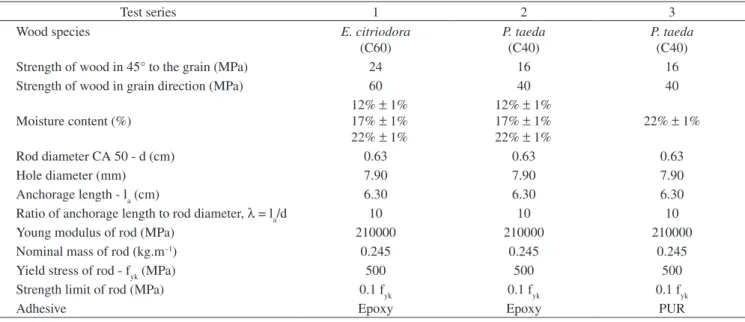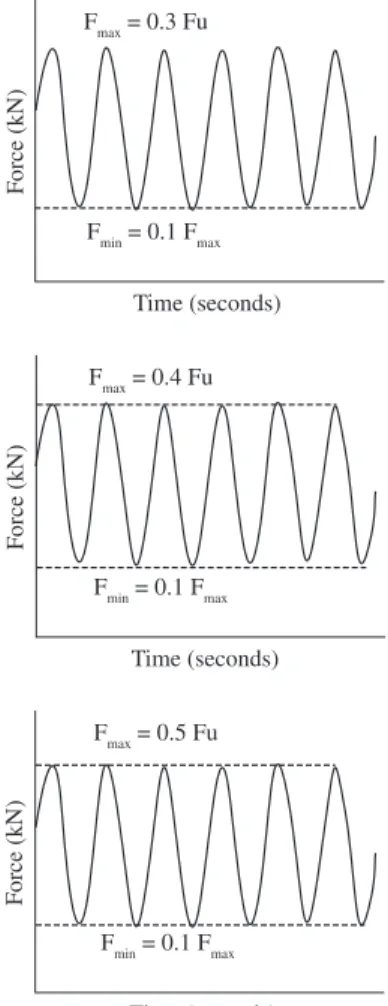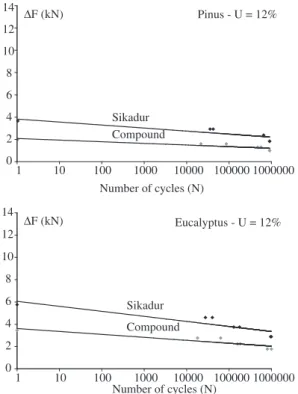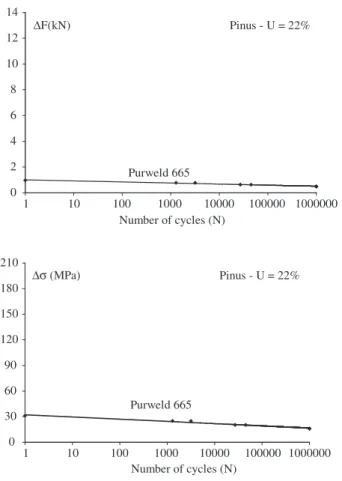*e-mail: juliocesarmolina@yahoo.com
Pullout Strength of Axially Loaded Steel Rods Bonded in
Glulam at a 45° Angle to the Grain
Julio Cesar Molina*, Carlito Calil Junior, Marcelo Rodrigo Carreira
Laboratory of Wood and Timber Structures, São Carlos School of Engineering,
University of São Paulo – USP,
Av. Trabalhador Sancarlense, 400, CP 780, 13566-590 São Carlos - SP, Brazil
Received: May 14, 2009; Revised: November 12, 2009
This paper presents an experimental analysis of the pullout strength of bonded and axially loaded steel rods used as connector elements in log-concrete composite bridge decks. Static and cyclic tests were carried out to evaluate the fatigue of the connectors using two species of reforested wood, three types of commercial adhesives and three levels of wood moisture content. It was found that six failure modes (rod interface failure, timber interface failure, combined timber interface/rod interface failure, combined rod interface/timber substrate failure, rod failure, and adhesive failure) can occur in the geometry of a single test specimen. The results indicate the good performance of epoxy glued steel rod connectors for use in log-concrete composite bridge decks.
Keywords: pullout strength, bonded-in steel rods, structural adhesives, moisture content
1. Introduction
The importance of preserving Brazil’s tropical rainforests has gained increasing recognition in the country in recent years. Refor-ested pine and eucalyptus species grow rapidly and adapt easily to different climates. They are therefore major sources of wood around the world, and especially in Brazil, where these species are abundantly available1. The joint use of wood and concrete in the construction of log-concrete composite bridge decks results in elements with excel-lent structural characteristics, combining the best properties of each material, i.e., the wood works in the tension and the concrete in the compression. However, the use of a connection system is essential to enable the two materials to work together, as indicated in Figure 1. A connection system frequently used to join timber and concrete is the glued steel rod system, which is a low cost solution that is easy to implement. Brazil has no regulatory standards for the use of glued steel rod connectors in wood elements, although such standards have existed for over twenty years in several Scandinavian countries and in Germany2,3,4.
There are no limits for the length of anchorage of steel rod in the timber, but for anchorage lengths superior to twenty times the rod diam-eter the increments in the static strength of anchorage are insignificant. It is recommended that the diameter of the hole should be 1.25 times the diameter of the rod. Larger holes allow more tolerances but they should not be larger than 1.50 times the diameter of the bar12.
Besides, the ratios “λ” recommended to glued-in length “la” and the steel rod diameter “d” for rod test with axial loads are 10 and 20[7].
This paper presents the results of an experimental investigation of the pullout strength of steel rods glued in holes with large diameters in blocks of wood with different levels of moisture content, using commercial adhesives, for use in composite bridge decks.
2. Materials and Methods
The method used here to estimate the ultimate fatigue strength (Fu) of the connection system analyzed in the specimens followed the Brazilian wood standard 5. Two wood species, Eucalyptus citriodora
and Pinus taeda, and three types of commercial adhesives, two epoxy adhesives, Sikadur 32 and Compound Adhesive, with compressive strengths of 60 and 100 MPa, respectively, and a PUR adhesive, Purweld 665, with density of 1100 kg.m–3 were used in this study. According to manufacturer, a thickness of the layer adhesive between 1 and 2 mm is enough to promote the adherence. The number of cycles to failure and the failure mode were examined for one test specimen geometry and one rod diameter, as indicated in Table 1.
In the specimens, the dimensions of the blocks of wood were defined based on the assumption that the failure happened in the con-nection between wood and steel rod5. The hole diameter used was of 1.25 times the diameter of the rod12, resulting a thickness of the layer adhesive of 1.6 mm, that is according to recommended the adhesive manufacturer. The anchorage length was defined with λ = 10 in the ratioλ = la/d7. For each moisture content, wood specimen and type of adhesive, six replications of rods were considered. Therefore, three tests have been performed for each amplitude level, and the medium values of these tests were used as result.
3. Description of Tests
minimum loads to be applied in the cyclic fatigue tests. Thus, the maximum levels of force (Fmax) applied in the cyclic tests were 30, 40 and 50% of the ultimate static strength (Fu), estimated from the static tests of twinned specimens. The minimum level of force (Fmin) was determined as 10% of the maximum force (0.10Fmax) 10,11,12.
The test specimens with bonded-in steel rods were subjected to 1 × 106 load cycles at constant amplitude, and sinusoidal fatigue cycles at a frequency of 3 Hz[8,9]. Figure 3 shows the parameters used in the fatigue tests, with three load levels, using axial cy-clic fatigue loading (R = 0.1). Data obtained from static tests on twinned specimens were used to establish the maximum and
Figure 1. Wood/concrete connection system: a) Detail of a composite bridge deck before concreting; b) Glued steel rod connector at the interface of the materials.
Table 1. Static and fatigue test specimens.
Test series 1 2 3
Wood species E. citriodora
(C60)
P. taeda
(C40)
P. taeda
(C40)
Strength of wood in 45° to the grain (MPa) 24 16 16
Strength of wood in grain direction (MPa) 60 40 40
Moisture content (%)
12% ± 1% 17% ±1% 22% ±1%
12% ± 1% 17% ±1% 22% ±1%
22% ±1%
Rod diameter CA 50 - d (cm) 0.63 0.63 0.63
Hole diameter (mm) 7.90 7.90 7.90
Anchorage length - la (cm) 6.30 6.30 6.30
Ratio of anchorage length to rod diameter, λ = la/d 10 10 10
Young modulus of rod (MPa) 210000 210000 210000
Nominal mass of rod (kg.m–1) 0.245 0.245 0.245
Yield stress of rod - fyk (MPa) 500 500 500
Strength limit of rod (MPa) 0.1 fyk 0.1 fyk 0.1 fyk
Adhesive Epoxy Epoxy PUR
4. Results and Discussion
Six distinct failure modes were observed in the fatigue tests: a) Rod interface failure; b) Timber interface failure; c) Combined timber/rod interface failure; d) Combined rod interface/timber substrate failure; e) Rod failure, and f) Cohesive failure of the adhesive. Figure 4 and the Tables from 2 to 3 shows these fatigue failure modes and Table 4 shows the ultimate strength of the connection in the static tests.
4.1. Rod interface failure
Predominant failure mode in Pine test specimens with rods glued in with epoxy adhesives: Sikadur (about 83% of failures), and Compound (88% of failures). This failure mode also predominated (94% of failure) in the Eucalyptus test specimens with rods glued in with Sikadur epoxy adhesive.
4.2. Timber interface failure
Predominant failure mode in the Eucalyptus test specimens with rods glued in with Compound epoxy adhesive (89% of failures), for the highest gluing moisture contents.
4.3. Combined timber/rod interface failure
Failure mode observed in the Eucalyptus test specimens with rods glued in with Compound epoxy adhesive (about 12% of failures). This failure mode was also found in the Pine test specimens with rods glued in with Compound adhesive (11% of failures).
4.4. Combined rod interface/timber substrate failure
Pulloutfailure mode in the Pine test specimens with rods glued in with Sikadur epoxy adhesive (10% of failures).
4.5. Steel rod failure
Failure mode observed in the Pine (7% of failures) and Eucalyptus
(6% of failures) test specimens with rods glued in with Sikadur epoxy adhesive, at fewer cycles than the material’s data would suggest. This
Figure 3. Fatigue test parameters.
fact may be attributed to the threaded surface of the rods, which acted as a series of stress-raising notches. This result also indicates the influence of the sample’s geometry on its fatigue behavior.
4.6. Cohesive failure of the adhesive
This failure mode, which was observed only in the test specimens with rods glued in with PUR Purweld 665 (100% failure), was
at-tributed to the formation of CO2 bubbles in the bond, which reduced the effective area of cohesion due to the reaction of the adhesive with the moisture in the wood.
4.7. Fatigue graphs
Figures 5 to 8 show the data obtained from the fatigue tests at R = 0.1 (i.e., maximum tensile load = 10× minimum tensile load),
Figure 5. Fatigue performance of the epoxy adhesives – Moisture = 12%.
Table 2. Failure modes observed in fatigue tests – Pinus taeda.
Adhesive Failure modes recorded
(a) (b) (c) (d) (e) (f)
Sikadur * * *
Compound * *
Purweld 665 *
Table 3. Failure modes recorded in fatigue tests – Eucalyptus citriodora.
Adhesive Failure modes
(a) (b) (c) (d) (e) (f)
Sikadur * *
Compound * *
Table 4. Ultimate strength of the connection in the specimens – Static tests.
Adhesive Fu (kN)
Pinus taeda Eucalyptus citriodora
U = 12% U = 17% U = 22% U = 12% U = 17% U = 22%
Sikadur 7.42 5.82 11.52 5.76 10.89 8.06
Compound 4.04 3.97 3.06 6.90 3.98 3.60
Purweld 665 - - 0.97 - -
-illustrating the performance of each specimen and presented in the form of cycles to failure.
The experimental data were to fit with a linear approximation in a log graph. In this case, the linear approximation was used to get better and to facilitate the visualization of the results. The fatigue lives illustrated in Figures 5-8 illustrate the performance of specimens for a total 1 × 106 load cycles through variations of forces and stress. This is the order that would be expected from variable tensions tests at R = 0.1. It must be noted that observations and projected fatigue lives presented herein must be taken in the context of extrapolations based upon a limited data set.
5. Conclusions
The results of the fatigue tests indicated that the test specimens composed of rods glued into Eucalyptus citriodora wood blocks showed higher anchoring strength than the rods glued into the Pinus
taeda test specimens. The tests also revealed that increasing the level of loading substantially reduced the number of cycles to failure of the connections. The pullout strength of the connection after a total of 1 × 106 cycles (with R = 0.10) was 50% lower than its pullout strength in a single loading cycle.
Most of the fatigue failure modes were similar to those observed in the counterpart static tests. In other words, except for the rod fail-ure mode, the fatigue failfail-ure modes were relatively consistent with those observed in the static tests. The fatigue behavior was affected by the moisture content and type of adhesive used. In general, the higher the wood moisture content the lower the anchoring strength of the steel rod.
The steel rods glued in with Sikadur 32 epoxy adhesive showed an excellent performance at all the moisture contents analyzed: 12, 17 and 22%, and the predominant failure mode, in this case, was rod interface failure. The steel rods glued in with Compound epoxy adhesive also presented good results at a wood moisture content of 12%. The PUR adhesive was found to be unsuitable for bonding rods in timber test specimens because the surface of PUR adhesive often contains CO2 which forms bubbles in the bond, weakening its effective cohesion.
Fatigue failure may occur in any of the materials of the connec-tion, i.e., steel rod, adhesive, or timber. The fatigue behavior exhib-ited a visible impact, damaging mainly the steel rods. This behavior represents a potential fatigue risk of glued in rods used to form the connection in log-concrete composite bridge decks.
Acknowledgements
The authors gratefully acknowledge the financial support of FAPESP for this research. We are also indebted to LAMEM/EESC/ USP for providing laboratory support.
References
1. Miotto JL, Calil Junior C and Dias AA. “Log-concrete composite bridge decks in Brazil: requirements and applications”. Structural Engineer. 2009; 87:24-32.
2. Pigozzo JC. Estudos e aplicações de barras de aço coladas como conectores em lajes mistas de madeira e concreto para tabuleiros de pontes (Studies and applications of glued steel bars as connectors in timber-concrete composite slabs for bridge decks). [Thesis- Doctorate in Structural Engineering]. São Carlos: São Carlos School of Engineering, University of São Paulo; 2004. 358 p.
3. EUROPEAN PRESTANDARD. Design of timber structures. Bridges, Brussels, Belgium: European Committee for Standardization; July 1997. 45 p. (EUROCODE 5, Part 2).
4. Calil Jr. C. et al. Manual de projeto e construção de pontes de madeira (Manual of timber bridge design and construction). São Carlos: Suprema; 2006. 252 p.
5. Associação Brasileira de Normas Técnicas – ABNT. NBR 7190: Projeto de estruturas de madeira (Design of timber structures). Rio de Janeiro; 1997.
6. Baimbridge R, Mettem C, Harvey K and Ansell, M. Bonded-in rod connections for timber structures-development of design methods and test observation. International Journal of Adhesion & Adhesives. 2002; 22:47-59.
7. Baimbridge RJ, Harvey K and Mettem CJ. Fatigue Performance of Structural Timber Connections. In: International Associations for Bridge and Structural Engineering Conference – IABSE; Lahty, Finland; Aug. 2001. session B5, p. 573-578.
8. Weaver CA. Behaviour of FRP-reinforced glulam-concrete composite bridge girders. [MS thesis in Civil and Environmental Engineering]. Orono: Univ. of Maine; 2002.
9. Weaver CA, Davids WG, Dagher HJ. Testing and Analysis of Partially Composite Fiber-Reinforced Polyner-Glulam-Concreto Bridge Girders. Journal of Bridge Engineering – ASCE. July/August 2004:316-325.
10. Espinosa MM. Desenvolvimento de um modelo estatístico para aplicação no estudo de fadiga em emendas dentadas de madeira (Development of a statistical model for application in the study of fatigue in amendments of wood). [Thesis – Doctorate]. São Carlos: São Carlos School of Engineering, University of São Paulo; 2001. 165 p.
11. Molina JC. Análise do comportamento dinâmico da ligação formada por barras de aço coladas para tabuleiros mistos de madeira e concreto para pontes (Analysis of the dynamic behavior of the connectors formed by bonded-in steel rods for log-concrete composite deck bridges). [Thesis - Doctorate in Structural Engineering]. São Carlos: São Carlos School of Engineering, University of São Paulo; 2008. 240 p.
12. Buchanan A and Moss P. Desin of epoxied steel rods in glulam timber. In: Pacific Timber Engineering Conference; Rotorua, New Zeland; March 1999. p. 286-293.




